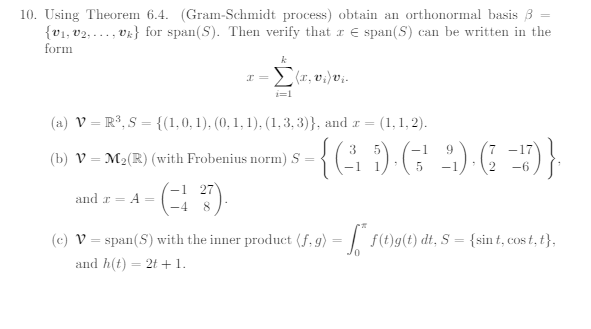10. Using Theorem 6.4. (Gram-Schmidt process) obtain an orthonormal basis 3 v} for span(S). Then verify that a Espan(S) can be written in the {0₁, 02,1 form and r = A I = (a) V = R³, S = {(1, 0, 1), (0, 1, 1), (1,3,3)}, and x = (1,1,2). (b) V M₂(R) (with Frobenius norm) S -1 27 k Σ(x, v.)vi. i=1 3 -1 9 {G) (2) 6_D)} 5 -1 (c) V = span(S) with the inner product (f, g) = f(t)g(t) dt, S = {sin t, cost, t}, and h(t) = 2t + 1.
10. Using Theorem 6.4. (Gram-Schmidt process) obtain an orthonormal basis 3 v} for span(S). Then verify that a Espan(S) can be written in the {0₁, 02,1 form and r = A I = (a) V = R³, S = {(1, 0, 1), (0, 1, 1), (1,3,3)}, and x = (1,1,2). (b) V M₂(R) (with Frobenius norm) S -1 27 k Σ(x, v.)vi. i=1 3 -1 9 {G) (2) 6_D)} 5 -1 (c) V = span(S) with the inner product (f, g) = f(t)g(t) dt, S = {sin t, cost, t}, and h(t) = 2t + 1.
Linear Algebra: A Modern Introduction
4th Edition
ISBN:9781285463247
Author:David Poole
Publisher:David Poole
Chapter7: Distance And Approximation
Section7.1: Inner Product Spaces
Problem 37EQ
Related questions
Question

Transcribed Image Text:10. Using Theorem 6.4. (Gram-Schmidt process) obtain an orthonormal basis 3
v} for span(S). Then verify that a Espan(S) can be written in the
{0₁, 02,1
form
I =
-1 27
k
Σ(x, v.)vi.
i=1
(a) V = R³, S = {(1, 0, 1), (0, 1, 1), (1,3,3)}, and x = (1,1,2).
(b) V M₂(R) (with Frobenius norm) S
and r = A
(c) V = span(S) with the inner product (f, g) = f(t)g(t) dt, S = {sin t, cost, t},
and h(t) = 2t + 1.
3
-1 9
{G) (2) 6_D)}
5
-1
Expert Solution
This question has been solved!
Explore an expertly crafted, step-by-step solution for a thorough understanding of key concepts.
Step by step
Solved in 2 steps with 1 images

Recommended textbooks for you

Linear Algebra: A Modern Introduction
Algebra
ISBN:
9781285463247
Author:
David Poole
Publisher:
Cengage Learning

Elementary Linear Algebra (MindTap Course List)
Algebra
ISBN:
9781305658004
Author:
Ron Larson
Publisher:
Cengage Learning

Algebra & Trigonometry with Analytic Geometry
Algebra
ISBN:
9781133382119
Author:
Swokowski
Publisher:
Cengage

Linear Algebra: A Modern Introduction
Algebra
ISBN:
9781285463247
Author:
David Poole
Publisher:
Cengage Learning

Elementary Linear Algebra (MindTap Course List)
Algebra
ISBN:
9781305658004
Author:
Ron Larson
Publisher:
Cengage Learning

Algebra & Trigonometry with Analytic Geometry
Algebra
ISBN:
9781133382119
Author:
Swokowski
Publisher:
Cengage